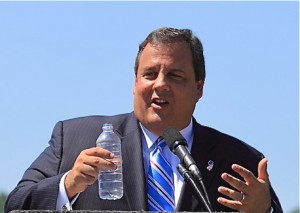Living In The Past
Republicans Legislators Challenge Republican Governor’s Budget
Letter to Gov. Demands Restoration of Environmental Cuts
“Among all the responsibilities of government, there are few of greater importance, or of more concern to the public than the protection of New Jersey’s environment and the quality of public health.”
Oh, we won’t give in,
We’ll keep living in the past. ~~~ Jethro Tull (1969 – YouTube listen)
[Update: 4/15/13 – The Bergen Record kicks off the Earth Day/Week spinfest with an echo of my theme below about Republicans from the past: Former Governor Kean calls on Christie to protect, add open spaces
A few quick points on that story:
1) Kean called for Christie to do more on climate change as well as open space. The headline should reflect that. So, here is a perfect example of the political and media risks of Keep it Green Coalition – in this case, they chose to emphasize open space over climate and the media went along.
2) There is s strong irony that was ignored. Kean used executive power to impose a moratorium on development to pressure the Legislature to pass the Wetlands Act. He was following the lead of Gov. Byrne, who did the same thing to secure the Pinelands Act.
In contrast, Gov. Christie did the opposite: he used Executive Orders to ROLL BACK environmental protections. Christie is the first Gov. in 40 years with NO ENVIRONMENTAL LEGACY.
3) The story only mentions the sales tax option as the financing mechanisms – that is the worst of 3 options on the table. – end update]
As the Christie DEP’s FY’14 budget is up for legislative consideration in the Senate on Monday, I’m reminded that – back in the day – there were Republicans who supported environmental protection, and they backed that support up with passage of laws and sufficient funds to DEP to enforce them.
Back in the day, the Governor was not the Bully In Chief or perceived as King.
Legislators, at times, would put the public interest before crude partisan politics.
Legislators did not surrender the reins of policy or the power of the purse to an arrogant and over-reaching Executive Power.
Really – here’s proof! Look at all those Republican Senators challenging Republican Governor Whitman’s DEP budget (only 1 Senator remains today, and he wouldn’t flush the toilet without asking for Christie’s permission).
Now, wouldn’t you think today’s Senate Democrats could do at least as much as their Republican predecessors? (horrendous policy record aside, if only for the fact that Christie stole over $800 million in Clean Energy Fund money)
EXHIBIT 1
NEW JERSEY SENATE,
Trenton, NJ, May 16, 1996.
The HONORABLE CHRISTINE TODD WHITMAN, Governor,
State of New Jersey
State House CN-001
Trenton, NJ 08625-0001.
DEAR GOVERNOR WHITMAN:
Among all the responsibilities of government, there are few of greater importance, or of more concern to the public than the protection of New Jersey’s environment and the quality of public health. We know that protecting these important concerns, and carrying out these responsibilities through appropriate State actions and support is a priority you share with the Legislature and the general public. It is in recognition of that shared commitment to protecting New Jersey’s environment and public health that we write to you today.
We are greatly concerned that your proposed budget for fiscal year 1997 does not adequately provide the necessary resources to State government to meet the environmental challenges facing the State. This is especially true in the proposed funding for the Department of Environmental Protection.
The proposed budget would require dramatic reductions in scientific, technical and human resources critical to the mission of the Department. In a State facing the environmental issues New Jersey does, we need to respond aggressively to the challenges of insuring that our air is safe to breath, the water safe to drink or the empty lot next door safe to play in. It is highly questionable as to whether the Department will maintain the requisite expertise and resources under the fiscal year 1997 budget proposal to answer these questions and respond in a way protective of public health and the environment.
We are also concerned that the proposed reduction in resources will not fulfill the new approaches to environmental protection. The successful implementation of the initiatives under discussion will require additional resources above and beyond those currently available to the DEP. Many of the “reengineering” initiatives being undertaken by the Department will be fundamentally handicapped by the proposed reductions in resources contained in the current budget proposal.
Due to these concerns we feel that it is important that you be aware we may not be able to support this budget proposal, should it come before the Senate in its current form The historical erosion of staffing at the Department experienced over past budget cycles cannot be continued because the environmental goals we have outlined above will not be attainable.
We feel strongly that the proposed layoffs of DEP personnel will negatively impact the Department’s ability to effectively safeguard the environment and protect public health. Therefore, we cannot support a final DEP budget which contains employee layoffs.
We are, of course, committed to working with you to restore the resources we feel are necessary to carry out the critical functions of the Department of Environmental Protection.
We feel that it is very possible to identity appropriate resources, sources of funding and approaches to achieve this, and we ask for the opportunity to explore these with you and your staff.
Respectfully yours,
JOHN O. BENNETT,
Senate Majority Leader.
ANDREW R. CIESIA,
Senator.
JOSEPH M. KYRILLOS,
Senator.
HENRY P. MCNAMARA,
Senator.
JOSEPH A. PALAIA,
President Pro Tempore.
JACK G. SINAGRA,
Senator.
ROBERT W. SINGER,
Senator.


